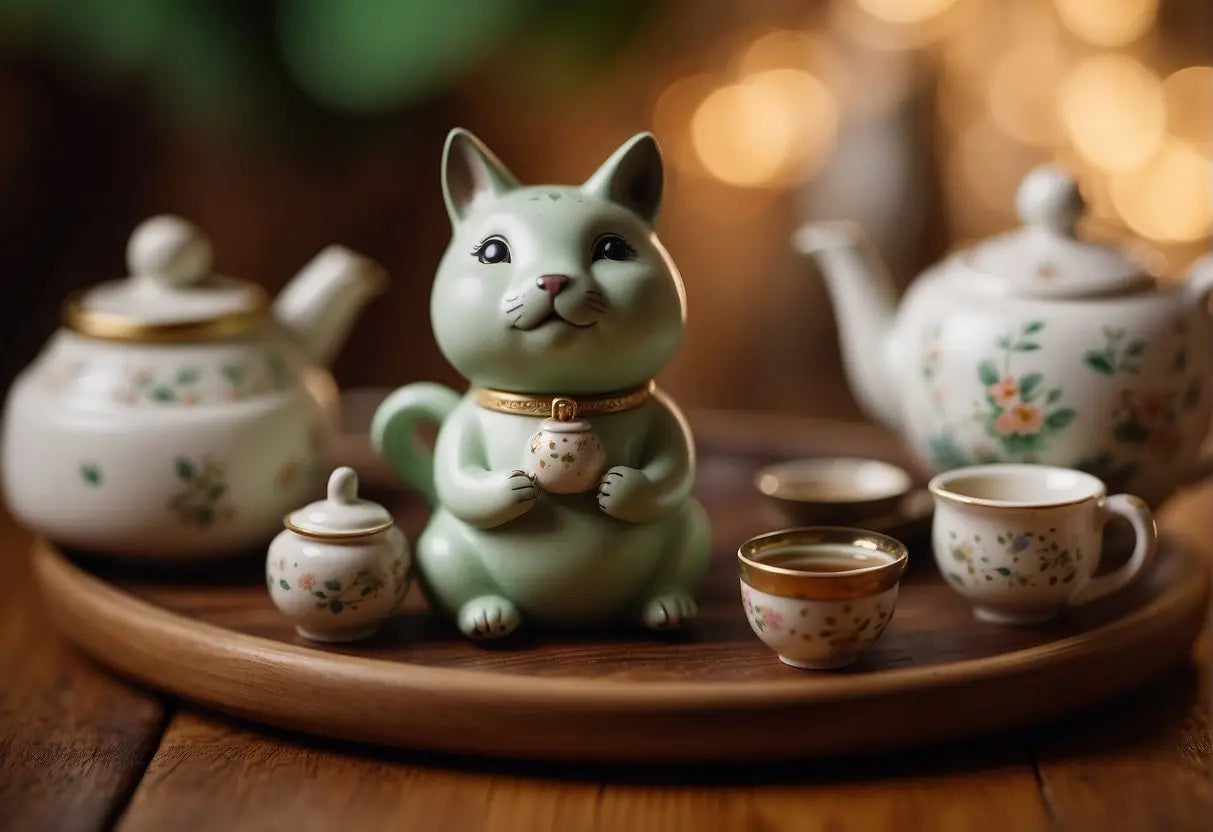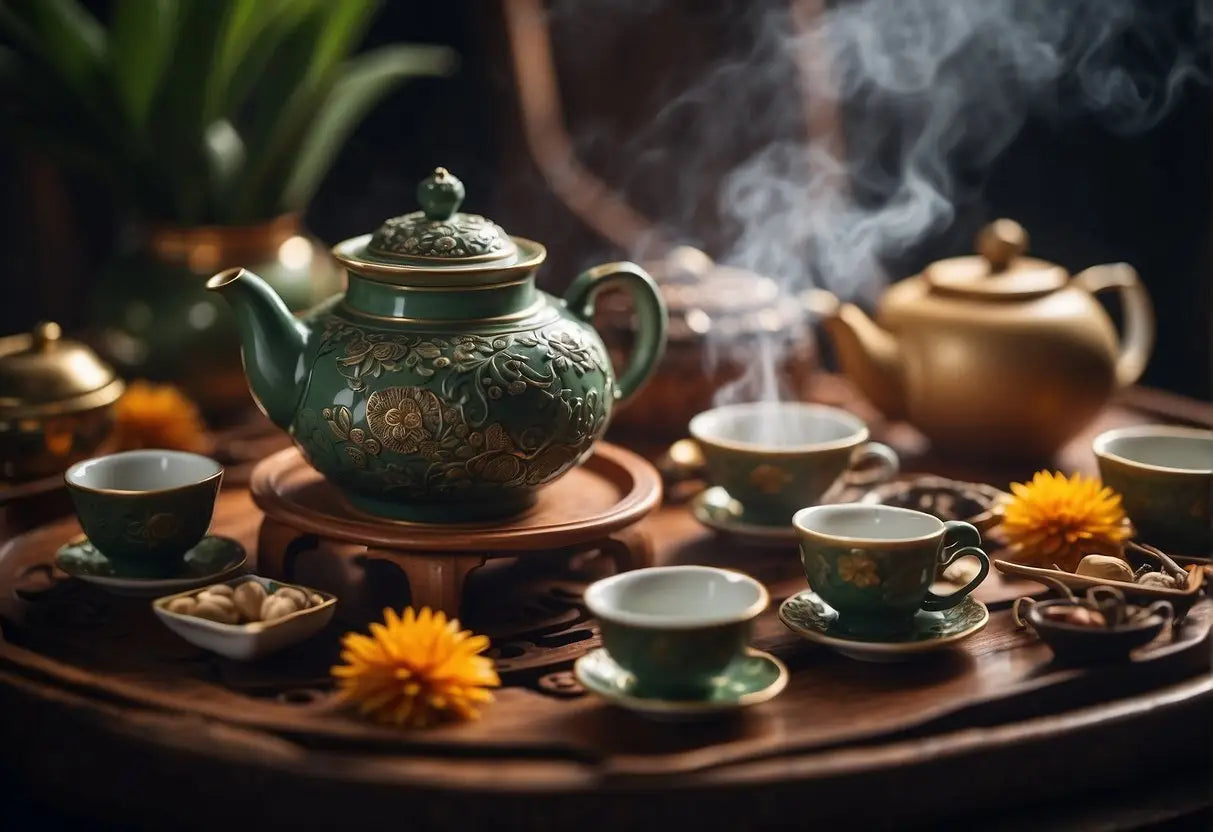What is a Tea Pet
Tea pets are small clay figures that are often used for decoration and during tea ceremonies. These unique artifacts are steeped in cultural traditions and have an intriguing historical lineage.
Origins and History
You might be surprised to learn that tea pets originated during the Yuan dynasty (1271-1368) in China. Primarily made from the same Zisha clay used for Yixing teapots, these charming figurines were first created in the town of Yixing, in the Jiangsu province. They began as a byproduct of teapot manufacturing but soon gained popularity for their ornamental value and unique interactive qualities.
Cultural Significance
For you as an enthusiast of tea culture, understanding the importance of tea pets is crucial. In Eastern tea rituals, tea pets symbolize good luck, wealth, and prosperity. Owners pour tea over these figurines during tea service, a practice believed to bring good fortune. Tea pets also serve as a test for the water temperature: as they are typically unglazed, over time, they absorb tea oils and may change color or develop a sheen, indicating the quality and temperature of the poured tea.
Bestsellers
Types of Tea Pets

Tea pets are small clay figures used in the tea ceremony for various aesthetic and traditional functions. These artifacts come in different materials and styles, each with its unique characteristics and cultural significance.
Clay Tea Pets
Clay tea pets are the most common type, crafted from various clays. They are known for their ability to absorb tea and gradually change color over time. You may encounter:
- Zisha Clay Tea Pets: Made from the same clay as Yixing teapots, they are prized for their quality and durability.
- Purple Clay Tea Pets: These are similar to Zisha clay pets but often come in different shades of purple.
Porcelain Tea Pets
Porcelain tea pets are made from high-fired ceramic and are recognized for their glossy finish and intricate designs. They typically do not change color like their clay counterparts. Key points include:
- Glazed Porcelain Tea Pets: Featuring a smooth surface that reflects the tea's aroma and essence.
- Hand-Painted Porcelain Tea Pets: Often adorned with delicate artistry, adding a layer of aesthetic value.
Yixing Tea Pets
Yixing tea pets are a highly sought-after subset of clay tea pets, originating from the Yixing region of China. They are famed for:
- Fine Craftsmanship: Each pet is a testament to the Yixing pottery tradition.
- Cultural Significance: Deeply rooted in Chinese tea culture, these tea pets can symbolize good luck and prosperity.
Creation Process

In crafting a tea pet, materials are chosen with care, and specific techniques are applied to shape, adorn, and finalize the piece, culminating in a unique artistic creation.
Materials Used
- Clay Types: Commonly, Yixing clay is the preferred material for tea pets due to its quality and porosity, which allow it to gradually absorb tea and change color over time.
- Additives: Sometimes, materials like metal oxides are mixed with the clay to enhance color and texture.
Crafting Techniques
- Shaping: Artists often hand mold or sculpt tea pets, utilizing tools for fine detail work.
- Detailing: Intricate designs may be carved or added onto the tea pet's surface before firing.
Firing and Glazing
- First Firing: The shaped clay is initially fired at a temperature between 1,100 to 1,200 degrees Celsius to harden.
- Glazing (Optional): Some tea pets are glazed to achieve a glossy finish, while others are left unglazed to retain the clay's natural texture.
- Second Firing: If glazed, a second firing sets the glaze. The exact temperature of this firing can vary based on the glaze composition.
Uses and Rituals

Tea pets are an integral part of the tea experience, blending tradition with a personal touch. They are not just decorative but carry meaning and are actively engaged during tea rituals.
Tea Ceremony Integration
During a tea ceremony, you may notice small clay figures sitting atop the tea tray. These are tea pets. They serve several roles in this context:
- Witnesses to the Ritual: Your tea pet is thought to absorb the tea's essence, witnessing countless ceremonies.
- Testing Water Temperature: Pouring hot water over your tea pet helps you gauge if the water is hot enough for brewing tea. An ideal temperature will produce changes in the pet’s appearance over time.
- Spill Recipient: Any excess or used tea is poured over the tea pet, serving a practical function of waste disposal.
Nurturing a Tea Pet
The process of nurturing your tea pet involves repeated dousings with tea over days, months, or even years. Here are the steps:
- Selection of Tea: Choose the type of tea you will consistently use, as different teas can affect the pet's coloration and sheen.
- Regular Pouring: Every time you brew tea, pour the leftovers on your tea pet to nourish it.
- Minimal Cleaning: Only use water to clean your tea pet; soaps can strip essential oils absorbed from the tea.
Symbolism and Purpose
Tea pets carry a wealth of meaning:
Lao Ban Zhang
- Good Fortune: Many are shaped like animals or mythical creatures that symbolize good luck or prosperity.
- Cultural Icons: Some represent significant cultural symbols or historical figures, serving as a nod to heritage.
- Personal Reminders: Your tea pet can act as a personal symbol, reflecting your character or aspirations.
Each tea pet’s purpose can vary, but what binds them is their role in the personalization of your tea ritual.
Maintenance and Care
Maintaining your tea pet requires attention to detail to ensure its longevity. Regular care keeps it aesthetically pleasing and preserves its unique properties.
Cleaning Routine
-
Daily:
- Rinse with clean, warm water after each use.
-
Weekly:
- Gently brush with a soft brush to remove tea residue.
Ensure you avoid harsh detergents, as they can damage the tea pet's surface.
Tea Nourishing
Frequent Nourishing: Pour leftover tea over your tea pet to develop a gradual patina and enhance its sheen. Over time, your tea pet will absorb the tea, enriching its color and texture.
Avoiding Damage
- Protect your tea pet from drops or hard impacts.
- Do not use abrasive sponges or scourers.
- Keep your tea pet in a stable environment; avoid extreme temperatures.
Additional Tips
- Use filtered water for cleaning to prevent mineral build-up.
- Every few months, soak your tea pet in a strong tea brew for several hours for deep nourishment.
By adhering to these simple maintenance and care guidelines, your tea pet will grow more lustrous and charming with each tea session.
Collection and Appreciation
When you begin collecting tea pets, you're entering a world rich with cultural significance and artistic detail. Your collection can focus on various aspects:
- Materials: Tea pets are often made from Yixing clay, but you can find them in a myriad of materials, such as porcelain or even precious metals.
- Craftsmanship: Look for intricate designs that showcase the creator's skill.
- Themes: Animals, mythical creatures, and Buddha figures are popular.
Starting Your Collection
- Choose a focus: material, theme, or craftsmanship.
- Visit specialty shops or online marketplaces.
- Attend tea ceremonies or expos for unique finds.
Appreciating Your Tea Pets
- Inspect the textures and colors; each pet will change hue with repeated tea pouring.
- Display them prominently during tea sessions; their presence is believed to bring good luck.
- Pair them with your tea set to enhance the aesthetic of your ritual.
Maintenance
- Rinse with clear water after use to maintain the patina.
- Avoid soap as it can seep into the clay and affect the tea's flavor.
By curating your collection with intention and nurturing your tea pets with care, you'll deepen your appreciation for this delightful tradition.
Frequently Asked Questions
In this section, you'll find detailed answers to some of the most common inquiries about tea pets, from their maintenance to their cultural importance.
How do you care for and 'raise' a tea pet over time?
To properly care for your tea pet, regularly pour leftover tea over it. This helps develop a unique patina over time. Avoid using soap or chemicals as they can damage the tea pet's clay body.
What materials are commonly used in the making of tea pets?
Tea pets are usually crafted from unglazed Yixing clay, which is highly absorbent and changes color with repeated tea exposure. Other materials may include purple sand clay, porcelain, and even resin.
Can you explain the cultural significance behind tea pets?
Tea pets symbolize good luck, fortune, and happiness in Chinese culture. They reflect the art of tea ceremonies, invoking a sense of companionship and tradition for tea enthusiasts during their tea rituals.
What is the proper way to pour tea over a tea pet, and why is this done?
Pour warm tea over your tea pet in a gentle and continuous stream. This ritual 'nourishes' the pet, creating a glossy sheen over time and symbolically sharing your tea with a cherished companion.
What variety of tea pets can one typically find, such as clay or antique?
You can find a wide range of tea pets, from modern clay figures to rare antique collectibles. They come in various shapes, such as animals, mythical creatures, or Buddhist figures, each with their own story.
How do the interactive features of tea pets, like 'spitting', enhance the tea-drinking experience?
Interactive tea pets, which may spit water or reveal hidden colors when drenched with tea, add a playful and lively element to the tea-drinking ritual, making it an engaging and entertaining experience.
← Older post Newer post →











